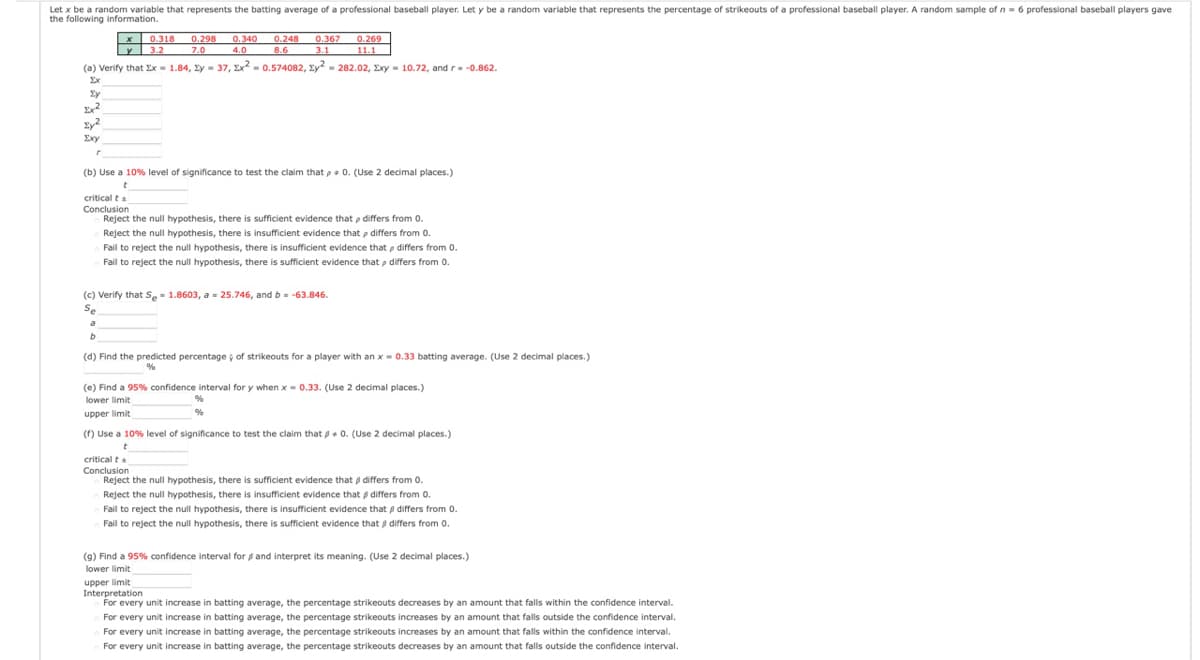Let x be a random variable that represents the batting average of a professional baseball player. Let y be a random variable that represents the percentage of strikeouts of a professional baseball player. A random sample of n = 6 professional baseball players gave the following information. x 0.318 0.298 0.340 0.248 0.367 0.269 y 3.2 7.0 4.0 8.6 3.1 11.1 (a) Verify that Ex= 1.84, y = 37, 2x2-0.574082, xy2-282.02, Exy 10.72, and r = -0.862. Ex Sy Ix² zy2 Exy (b) Use a 10% level of significance to test the claim that p = 0. (Use 2 decimal places.) critical ta Conclusion Reject the null hypothesis, there is sufficient evidence that differs from 0. Reject the null hypothesis, there is insufficient evidence that differs from 0. Fail to reject the null hypothesis, there is insufficient evidence that differs from 0. Fail to reject the null hypothesis, there is sufficient evidence that differs from 0.
Let x be a random variable that represents the batting average of a professional baseball player. Let y be a random variable that represents the percentage of strikeouts of a professional baseball player. A random sample of n = 6 professional baseball players gave the following information. x 0.318 0.298 0.340 0.248 0.367 0.269 y 3.2 7.0 4.0 8.6 3.1 11.1 (a) Verify that Ex= 1.84, y = 37, 2x2-0.574082, xy2-282.02, Exy 10.72, and r = -0.862. Ex Sy Ix² zy2 Exy (b) Use a 10% level of significance to test the claim that p = 0. (Use 2 decimal places.) critical ta Conclusion Reject the null hypothesis, there is sufficient evidence that differs from 0. Reject the null hypothesis, there is insufficient evidence that differs from 0. Fail to reject the null hypothesis, there is insufficient evidence that differs from 0. Fail to reject the null hypothesis, there is sufficient evidence that differs from 0.
MATLAB: An Introduction with Applications
6th Edition
ISBN:9781119256830
Author:Amos Gilat
Publisher:Amos Gilat
Chapter1: Starting With Matlab
Section: Chapter Questions
Problem 1P
Related questions
Question
Please help me answer this

Transcribed Image Text:Let x be a random variable that represents the batting average of a professional baseball player. Let y be a random variable that represents the percentage of strikeouts of a professional baseball player. A random sample of n = 6 professional baseball players gave
the following information.
x 0.318 0.298 0.340 0.248 0.367
y 3.2
0.269
11.1
7.0
4.0
8.6
3.1
(a) Verify that Ex= 1.84, y = 37, Ex2 = 0.574082, xy2 = 282.02, Exy 10.72, and r= -0.862.
Ey
2x²
2y²
Exy
r
(b) Use a 10% level of significance to test the claim that p = 0. (Use 2 decimal places.)
t
critical t
Conclusion
Reject the null hypothesis, there is sufficient evidence that differs from 0.
Reject the null hypothesis, there is insufficient evidence that differs from 0.
Fail to reject the null hypothesis, there is insufficient evidence that differs from 0.
Fail to reject the null hypothesis, there is sufficient evidence that differs from 0.
(c) Verify that Se 1.8603, a= 25.746, and b= -63.846.
-
Se
a
b
(d) Find the predicted percentage of strikeouts for a player with an x=0.33 batting average. (Use 2 decimal places.)
%
(e) Find a 95% confidence interval for y when x 0.33. (Use 2 decimal places.)
lower limit
%
upper limit
%
(f) Use a 10% level of significance to test the claim that 0. (Use 2 decimal places.)
t
critical t
Conclusion
Reject the null hypothesis, there is sufficient evidence that differs from 0.
Reject the null hypothesis, there is insufficient evidence that differs from 0.
Fail to reject the null hypothesis, there is insufficient evidence that differs from 0.
Fail to reject the null hypothesis, there is sufficient evidence that differs from 0.
(9) Find a 95% confidence interval for and interpret its meaning. (Use 2 decimal places.)
lower limit
upper limit
Interpretation
For every unit increase in batting average, the percentage strikeouts decreases by an amount that falls within the confidence interval.
For every unit increase in batting average, the percentage strikeouts increases by an amount that falls outside the confidence interval.
For every unit increase in batting average, the percentage strikeouts increases by an amount that falls within the confidence interval.
For every unit increase in batting average, the percentage strikeouts decreases by an amount that falls outside the confidence interval.
Expert Solution
This question has been solved!
Explore an expertly crafted, step-by-step solution for a thorough understanding of key concepts.
This is a popular solution!
Trending now
This is a popular solution!
Step by step
Solved in 3 steps

Recommended textbooks for you

MATLAB: An Introduction with Applications
Statistics
ISBN:
9781119256830
Author:
Amos Gilat
Publisher:
John Wiley & Sons Inc

Probability and Statistics for Engineering and th…
Statistics
ISBN:
9781305251809
Author:
Jay L. Devore
Publisher:
Cengage Learning

Statistics for The Behavioral Sciences (MindTap C…
Statistics
ISBN:
9781305504912
Author:
Frederick J Gravetter, Larry B. Wallnau
Publisher:
Cengage Learning

MATLAB: An Introduction with Applications
Statistics
ISBN:
9781119256830
Author:
Amos Gilat
Publisher:
John Wiley & Sons Inc

Probability and Statistics for Engineering and th…
Statistics
ISBN:
9781305251809
Author:
Jay L. Devore
Publisher:
Cengage Learning

Statistics for The Behavioral Sciences (MindTap C…
Statistics
ISBN:
9781305504912
Author:
Frederick J Gravetter, Larry B. Wallnau
Publisher:
Cengage Learning

Elementary Statistics: Picturing the World (7th E…
Statistics
ISBN:
9780134683416
Author:
Ron Larson, Betsy Farber
Publisher:
PEARSON

The Basic Practice of Statistics
Statistics
ISBN:
9781319042578
Author:
David S. Moore, William I. Notz, Michael A. Fligner
Publisher:
W. H. Freeman

Introduction to the Practice of Statistics
Statistics
ISBN:
9781319013387
Author:
David S. Moore, George P. McCabe, Bruce A. Craig
Publisher:
W. H. Freeman